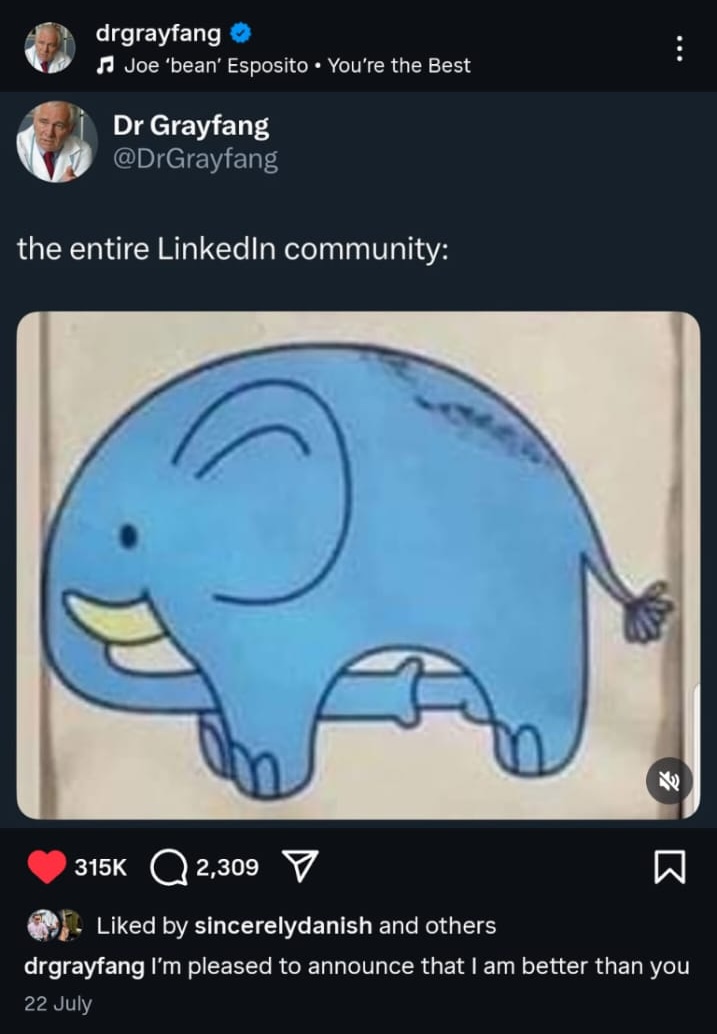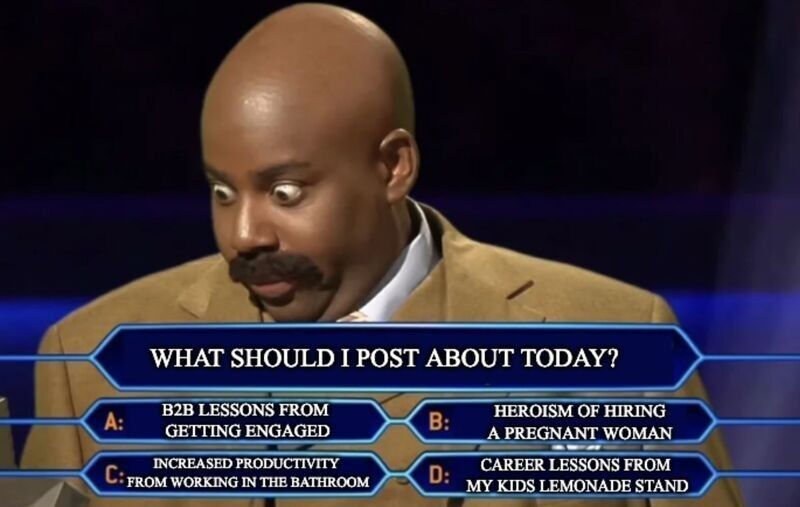Earlier this month, I posted on LinkedIn about a topic I’ve been sitting with for a while:
It clearly struck a chord. The post sparked DMs, client chats, and a fair bit of internal reflection, so I thought I’d bring those thoughts together here.
Pre-Covid, I was out there: events, networking breakfasts, founder meetups, drinks with marketers. It helped grow my business, build trust, and get real feedback fast. But it also drained me.
And I’m not alone. Many of my clients - particularly founders and senior marketers - feel the same. There’s a quiet shift happening: a collective question mark around whether traditional networking is worth the energy anymore.
So here's the question... can LinkedIn replace in-person networking? It might seem like a simple comparison of platforms or preferences. But underneath it sits a much bigger conversation about trust, visibility, and the way B2B relationships are built in 2025.
Because the truth is, how we connect has fundamentally changed. And with it, how we market.
Showing Up Looks Different Now
As I mentioned, pre-2020, I was very much "in the room". I went to events, meetups, roundtables, breakfasts, workshops - you name it. It was energising, in the right context. But it was also demanding. Being "on" in a room full of strangers, delivering your value quickly, trying to gauge whether a conversation was meaningful or just polite small talk... it required emotional energy I didn’t always have in reserve.
Since the pandemic, I’ve noticed a shift. Not just in myself, but in clients, collaborators, and peers. Many of us have reevaluated how and where we spend our energy. There’s more discernment now. More boundaries. Less FOMO, more intentionality. That shift in mindset has also changed the way we approach visibility and commercial strategy with our clients, especially when it comes to networking.
Because while traditional in-person networking hasn’t disappeared, it no longer feels like the default route to building relationships. At the same time, LinkedIn has transformed. It’s become more open, more useful, and in some cases, more authentic. It’s no longer just about job titles and announcements - it’s where people are sharing ideas, building credibility, and making connections at scale... nearly anyway:

So over the past couple of years, I’ve leaned into showing up on LinkedIn more consistently, and it’s been a significant driver of leads and opportunities. But that doesn’t mean it always feels easy. There’s still a tension around putting yourself out there on social platforms. Clients often describe that feeling of “ick” when they post something personal or promotional, and I completely relate. The discomfort is real, even when the results are good.
So back to the question: can LinkedIn truly replace in-person networking?
That’s what I want to explore in this reflection - looking at the pros and cons of both approaches, and how they each contribute to building trust, visibility, and meaningful relationships in B2B. Not to declare a winner, but to help you make more intentional choices about how and where you show up.
In-Person Networking: Pros and Cons
Let’s start with the traditional format. In-person networking has been a staple of B2B marketing for decades, and for good reason.
.jpeg)
The advantages are real:
Deeper trust is built faster. According to Harvard Business Review, face-to-face requests are 34 times more effective than emails in terms of building initial trust and prompting action. The nuance of body language, tone of voice, and presence contributes to a stronger sense of rapport... something that’s harder to replicate online (unless of course you lean into posting videos).
Serendipity thrives. In-person events allow for unscripted interactions. According to Forbes, 85% of professionals say they build stronger and more meaningful relationships through face-to-face meetings. Some of the most valuable business relationships are sparked in the “in-between” moments: walking to the venue, chatting over coffee, or staying behind after a panel.
You see how people really operate. Observing how someone listens, responds, and engages in real time offers deeper insight into potential working relationships. That’s valuable context you don’t get from a profile picture or a comment thread.
But there are limitations too:
It’s time-intensive and energy-consuming. According to Eventbrite’s 2023 trends report, people are attending fewer events than before the pandemic, citing energy, cost, and lack of perceived value as key barriers.
Geography matters. Not everyone lives in a city with a thriving event calendar. And even when they do, commuting across town for a low-return networking event is rarely appealing. With clusters of events more traditionally being in cities, many people who opt to live outside cities are left behind.
Not all events are created equal. We’ve all been to the kind of event where the conversation is shallow and the follow-up non-existent. Without careful curation, the signal-to-noise ratio of traditional networking can be off-putting - and even counterproductive.
LinkedIn Networking: Pros and Cons
Over the past few years, LinkedIn has evolved into a powerful tool for visibility, thought leadership, and relationship-building. It’s no longer just a digital CV: it’s become a space where meaningful conversations and brand presence can happen at scale.

Where LinkedIn excels:
It’s scalable and consistent. A well-placed post can reach thousands, even in a niche industry. According to HubSpot, LinkedIn is 277% more effective for lead generation than Facebook or Twitter, making it the top platform for B2B marketers.
It suits different working styles. For time-poor founders or marketers who want to be intentional with how they show up, LinkedIn offers flexibility. You can write, refine, and publish at your own pace - on your own terms.
It enables niche targeting. With more than 61 million senior-level decision-makers on the platform, LinkedIn allows businesses to reach exactly the kind of people they want to work with - without needing a room full of name badges.
But it isn’t perfect:
Trust takes longer to build. While digital content gets you in front of people, it doesn’t always translate into connection. It's still a well-known fact that personal recommendations and peer conversations still carry more trust weight than branded content.
It’s easier to be misunderstood. Tone, nuance, and body language are all stripped away in a written post. Even thoughtful ideas can land flat, or worse, misinterpreted.
Consistency is key. The brands and individuals that see results on LinkedIn are those that show up regularly. That kind of presence requires planning, confidence, and time... something many teams struggle to maintain without support.
Building Trust: The Core of Both
Whether online or in person, the goal is the same: build trust. And in B2B marketing, trust is the primary driver of sales relationships. People don’t just buy services, they buy belief: belief that you understand their challenges, belief that you can deliver, belief that you share their standards and priorities.
That belief can begin in a conversation over coffee or through a comment on a post. But it grows through consistency, generosity, and clarity - no matter the channel.
So, Can LinkedIn Replace In-Person Networking?
Not entirely. But for many professionals, it’s becoming the more consistent and accessible tool. And that shift isn’t necessarily a downgrade: it’s a reframe.
In-person connection still offers depth and energy. But online platforms, when used well, offer reach, flexibility, and a way to show up on your own terms. It’s not about choosing one or the other, but rather about building a visibility strategy that suits your energy, your goals, and your audience.
Personally, I still attend live events, but I choose them carefully. I no longer say yes to everything, and I don’t measure my commitment by how often I’m in the room. I measure it by how consistently I’m showing up with intention: whether online or off.
And that’s the advice I give to clients too. You don’t have to be everywhere. But you do have to be present... with purpose!

Need help building your commercial strategy? Check out how we can help!

.png)
.png)
.png)
.png)
.png)
.png)
.png)
.png)
.png)
.png)


.png)